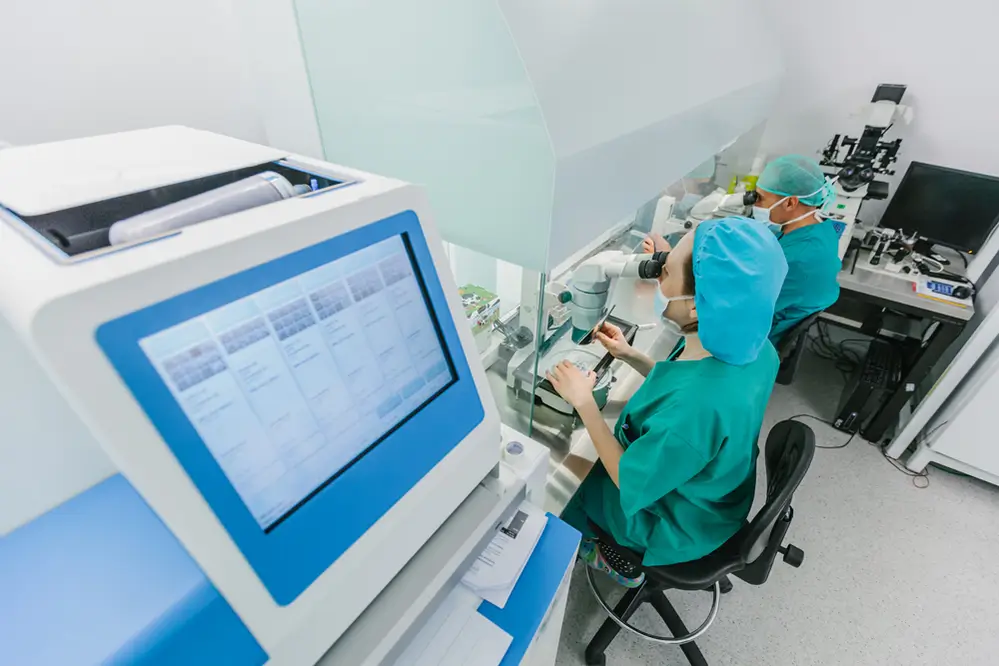
Assisted reproduction
Endometrial Receptivity Analysis (ERA)
Various factors can influence embryo implantation failure: uterine, hormonal, immunological, genetic, haematological, etc. Factors of paternal origin and the age of the mother can also influence this process.
The Endometrial Receptivity Analysis (ERA) enables us to reduce the probability of embryo implantation failure.
Here at Ginefiv, we perform a personalised embryo transfer 3 to 5 days after ovarian puncture. And, in the case of frozen embryos, this is carried out in a natural cycle or with coadjuvant medication which prepares the uterus so that it is an optimal state for this special moment.
In the event of an embryo implantation failure, we run a whole series of specific tests on both members of the couple in order to detect possible anomalies which may be affecting the implantation

Endometrial receptivity analysis
An endometrial receptivity analysis (ERA) determines whether or not the endometrium is receptive at a given point in the cycle by analysing a sample of the uterine lining.
This tissue sample is taken in a simple outpatient procedure during a natural cycle or after hormone preparation, in order to establish the best day for embryo transfer. An ERA determines whether or not the endometrium is receptive when the sample is taken by analysing a certain number of genes related to endometrial receptivity.
This allows us to detect possible displacements of the implantation window – something which occurs in 20-25% of cases of implantation failure – and to carry out a personalised embryo transfer based on the obtained results.
Bacteriological tests in implantation failure
Patients with implantation failure typically undergo an exploratory test called a hysteroscopy, in order to examine the interior of the uterine cavity.
In this test, in addition to assessing the uterus on an anatomical level, we assess the microbiology level via a tissue sample and a classic culture. This enables us to study the possible existence of chronic endometrial inflammation, which means that the endometrial environment within the uterine cavity is not the most ideal for embryo implantation.
Chronic endometritis can affect up to 30% of infertile patients and, in cases of recurrent implantation failure, this figure can rise up to 66%, according to some published studies.
In recent months, a new microbiological test has become available on the market: ALICE, which analyses the endometrial tissue at a microbiological level, using NGS (Next-Generation Sequencing) techniques to detect pathogenic bacteria. This is one of the most effective microbiology evaluations for the detection of germs which can cause chronic endometritis and it offers us the chance to provide an antibiotic treatment and a treatment to improve the endometrial environment.
The importance of healthy bacteria
The endometrial cavity is not a sterile cavity and a healthy endometrium needs to have an optimal amount of healthy bacteria, which are known as the endometrial microbiota (or endometrial flora).
This has led to the development of a new test, called EMMA, which evaluates this endometrial microbiota.
According to the latest studies published, low levels of healthy bacteria in the endometrium are associated with a worse endometrial environment for implantation. The realisation of these tests can tell us whether the endometrial flora levels are ideal and this enables us to offer recommendations that can balance them, thereby attempting to optimise the chances of implantation.
Ginefiv can now perform these three endometrial receptivity analyses with a single tissue sample, minimising the patient’s discomfort and trying to find out as much as we can about the processes which may be affecting the embryo implantation failure.



















